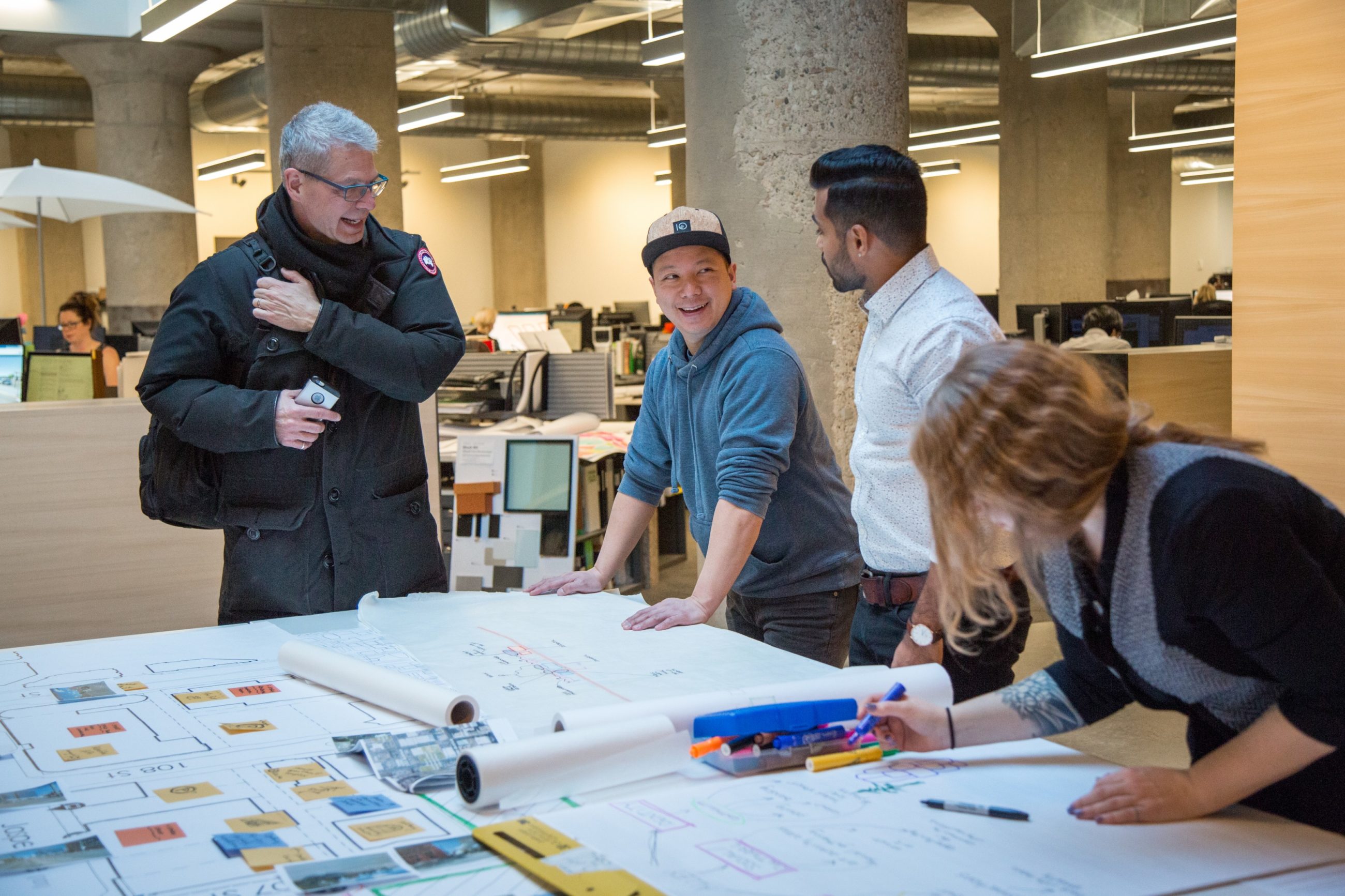
Last month, the inaugural DIALOG Design Residency in Honour of Tom Sutherland took place in the Edmonton studio. We hosted 9 students representing 6 disciplines from 6 universities across Canada to solve a community-related design challenge. Their mission for the week:
How could a laneway in downtown Edmonton be re-imagined and redeveloped as a catalyst to promote the revitalization, vibrancy, and liveliness of the surrounding urban environment?
Day 1 – Getting to know each other and settling in for the week
Residents introduced themselves and shared thematic precedents they researched in advance. They got acquainted with each other’s background and learned what they will be up to for the next few days. Following that, students mingled with Edmonton DIALOGers at a social reception in the lobby.

Day 2 – Introduction to downtown Edmonton and the study area
The day started out by learning about the downtown context and economic vitality, with lively and informative presentations from the City of Edmonton and Edmonton Economic Development Corporation. Following those, the students bundled up for a… we’ll say… brisk… ‘winter in Edmonton’ walk along the laneway. The study area is an alleyway just north of Edmonton’s Jasper Avenue, and runs between five city blocks in the heart of Downtown. They returned to the studio for an enlightening presentation from University of Alberta’s School of Public Health. After that, they finally got to put pen to paper, working in three groups of three.

Day 3 – Getting down to business
Continuing to work in small groups, the residents developed their ideas a little further before presenting to each other later that morning. Another guest presenter gave a glimpse into public art in Edmonton and as interventions for similar projects around the world. Armed with all the background info they need, students came together as one big “super group” to get their ideas aligned for the big presentation the next day.
Presenter: Katherine Kerr (Art Consultant and Public Art Expert)

Day 4 – Final presentation day!
Finishing touches were put on their presentation in the morning. The residents presented to DIALOGers across all studios (thanks for tuning in!) and invited guests from the community. After a wrap-up lunch where we toasted their hard work and chatted about the week in review, the students boarded planes back home with their minds buzzing from the wirlwind week.
The students presented what they worked on throughout the week to the Edmonton studio, and our other North American studios tuned in from afar. We were impressed by how well the students rose to the challenge! Coming up with a solution for the community challenge within a few days is no easy task. Rather than proposing one prescriptive solution, they guided us through a phased approach with a variety of ideas that built upon each other.
Phase 1: Paint and art can enliven a space and make it more welcoming. Minimal commitment by land owners. Introduce a food exchange outlet where nearby businesses can take leftover food and those that could use a helping hand are able to pick up.


Phase 2: Building out from the laneways, more development and buy-in from landowners is required for more permanent upgrades. Lighting, plantings, more art and specialty pavers are proposed.

Phase 3: Again, building on previous phases, the long term vision is to have permanent infrastructure and more spread out spaces that tie into a wider area around the laneways.


Key Themes
During the final question and answer period, students were challenged to capture their work in a single theme. Their responses:
-
Unity – Creating a sense of unity in the space. Wanting it to be unique yet unified, building off of its existing conditions.
-
Unsettling – Creating something unexpected where users are forced to interact with both the space and other users in a way that is unanticipated.
-
Collisions – Creating a space of encounter where multiple public groups interact, developing a planning structure that allows for something truly unique.
-
Connectivity – Between laneway and mainstreet, drawing people in from the codified streetscape into the wilds of the back lane.
-
Community identity – Using the laneway as an opportunity for the community to articulate and define its needs, aspirations, and perspectives.
-
Resiliency – Across all phases of implementation, there is an enduring quality of people’s use and occupation of the space, and there are diverse publics using it. The nitty gritty has some level of resiliency through all phases of development.
-
Engage – Engaging with all scales, all walks of life, people, built form and movement network.
-
Voice – Giving a voice, a platform, to multiple people through this project so that they can articulate their ambitions and desires for shared space in the Downtown. Their voices working on a common project become the catalyst for revitalizing the neighbourhood.
-
Mixture – Combining land uses, people, typologies, and programmatic elements in a sort of urban crucible.
9 students. 6 disciplines. 6 universities.
